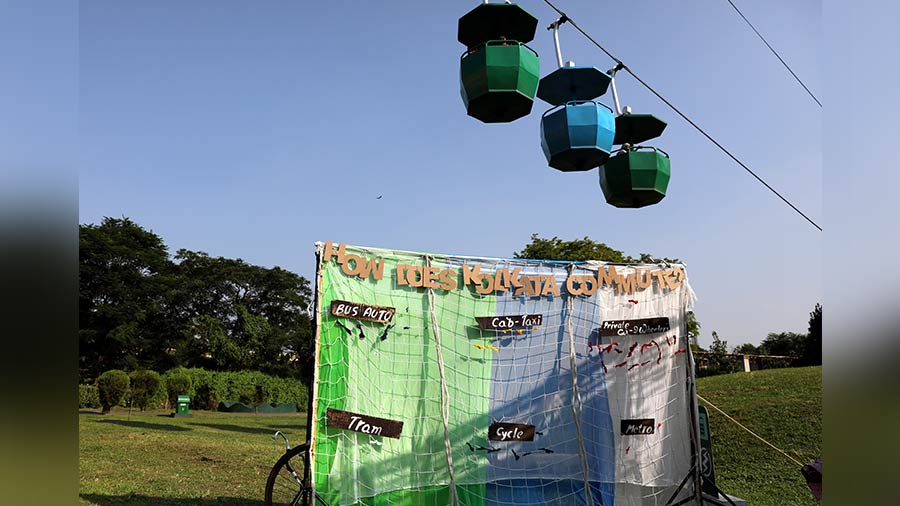Why did cyclones Amphan, Yash and Sitrang wreak havoc in the Sunderbans? The answer is blowin’ in the wind — depleting natural barriers.
The Goethe Institut/Max Mueller Bhavan, Kolkata, installed green pop-ups at three different locations in and around the city as part of Towards a Better Tomorrow under the Moving Kolkata, Kolkata Moving project aimed at encouraging people’s participation to engage, discuss and create awareness on climate change and initiate individual contribution in making a better planet.
A collaborative effort between artists and people, Towards a Better Tomorrow was held under the aegis of the “European Spaces of Culture” executed by European National Institutes for Culture (EUNIC) New Delhi and Kolkata and was funded by EUNIC Global, Brussels. Science City, Victoria Memorial and Kheyada High School were the venues of this unique pop-up installation where city-based artists, school students, environmental organisations came together for the cause.
Speaking to My Kolkata, Astrid Wege, director, Goethe Institut/Max Mueller Bhavan, said, “The project ‘Moving Kolkata, Kolkata Moving’ includes a website with different voices and ideas on sustainability in the city, an exhibition in Delhi (which Goethe Institut in the national capital is taking care of) and Towards a Better Tomorrow. All these deal with sustainability especially in big cities which is contributing to pollution and climate change. Kolkata is one of the hotspots of climate change hence we have this pop-up structure which travels to three different parts of the city to reach out to people.”
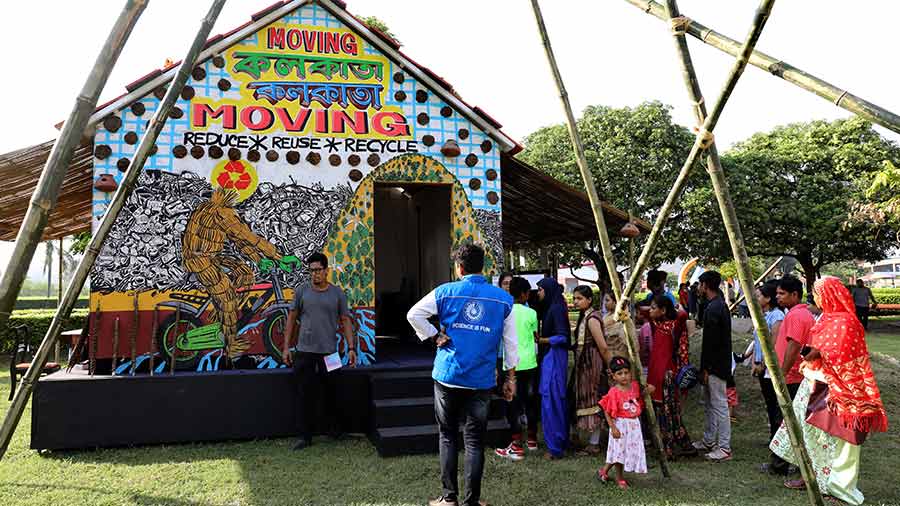
Photo by Arijit Sen/My Kolkata
On Sunderbans
The project themed Sunderbans kicked off at Science City on October 17. Architect and art curator Sayantan Maitra designed the installation through videos, documentaries, virtual reality experiences, highlighting the need of the hour to save the bordering mangroves of the Sunderbans from the harshness of climate change.
Sunderbans not only helms a community but is also a barrier protecting the mainland from the fury of nature. The house-shaped portable pop-up installation designed by artists Sumantra Mukherjee, Anup Pramanik and team, housed a virtual reality experience showcasing the Sunderbans, its community and how it is slowly drowning. Another installation on the open grounds depicted the barrier or shelter that Sunderbans is.
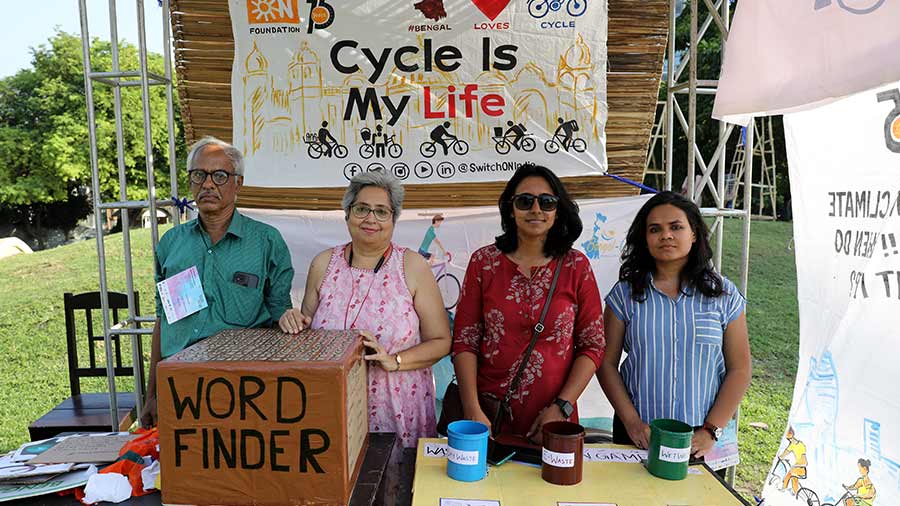
Photo by Arijit Sen/My Kolkata
Sayantan Maitra said, “I visited Sunderbans post-Amphan and Yash to study how human survival is possible after these cyclones. We need to spread a message on the reality of climate change which is happening in Kolkata and Sunderbans. This exhibition aims at educating people on climate change. We have a couple of audios and lectures on climate change. We have videos of the rising sea level. We have stories on Sunderbans and climate change. We also have footages of people who shot the cyclone with their phones showing us how they were impacted.’’
The Switch-on Foundation curated activities regarding waste segregation, air pollution, word games and more. Gargi Maitra, Outreach Lead and New Initiatives manager at SwitchOn Foundation said, “Through simple ways, we can make people aware of how their lifestyle is impacting climate change and how we can collectively reduce air pollution.’’

Photo by Arijit Sen/My Kolkata
Goethe Institut/Max Mueller Bhavan, in association with Disappearing Dialogues, held workshops for students from various institutes like The Heritage, EkTara NGO, Future Hope and more. The result of these workshops culminated in activities curated by the students which made the audience think about how individually they could play their part to save the environment.
Swetleena Ghosh, a Class XII student from The Heritage School, recalled, “While brainstorming on ideas at a workshop at Goethe Institut, we came up with ways to make people think about how they viewed the atmosphere and reflect upon their actions. It’s our responsibility to restore the environment for the future generations.”
Science City director, Anurag Kumar, said, “Climate change in Sunderbans will not just affect the people there but also those living here in Kolkata. We [Science City] at many fronts are trying to achieve sustainability. For power consumption, we have already installed a large solar panel on the rooftop. We are planning to set up our own waste management plant and are trying to develop a system of using the water from the pond [on campus] and irrigate at least part of the garden.’’
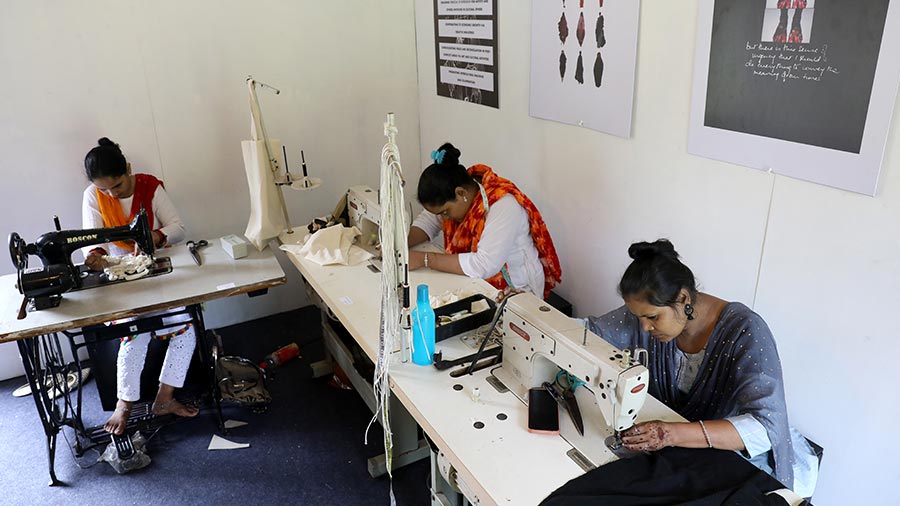
Photo by Arijit Sen/My Kolkata
On Recycling and Repairing
On October 19, designer Kallol Datta, curated details about sustainable fashion to educate visitors at the Victoria Memorial Hall. Clothes were sewn inside the mobile pop-up installation. According to Datta, “The project was aimed at tackling claims of sustainable practices being adapted by people in response to the climate crisis. The biggest sustainable adaptive practice I can think of is cultural sustainability which deals with multiple notions of assimilation and integration. We collected clothes and students from design colleges deconstructed and reconstructed these donated items into new garments. They were basically involved in recycling, repairing and reuse.’’
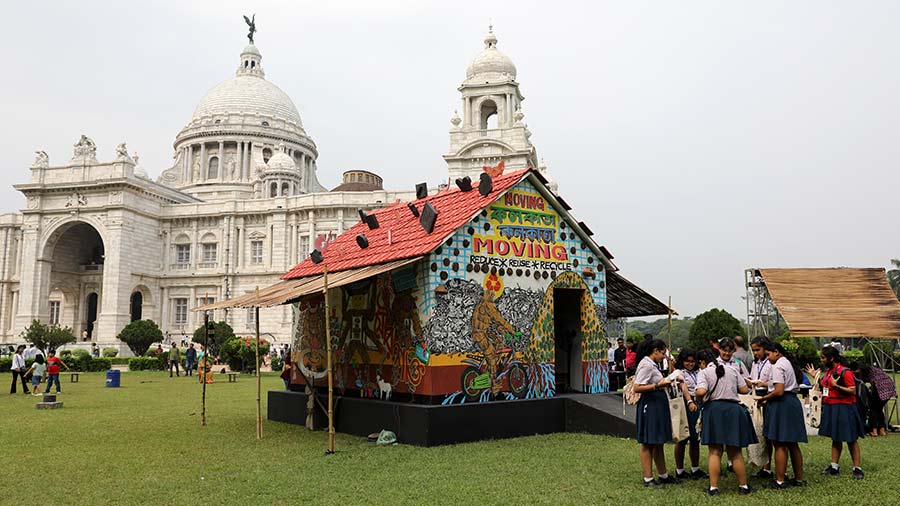
Photo by Arijit Sen/My Kolkata
The highlight of the exhibition was a block printing tent. Visitors were given bags, colours and blocks to make their own stuff. A photo booth installed gave them the opportunity to click a photograph with their bags and get an instant copy of the same as a souvenir.
Raju Raman, programme consultant, Victoria Memorial Hall said, “Victoria Memorial is open to any kind of collaboration associated with environmental sustainability, something for the future of mankind, recycling, repair and going away from the consumerist world. These are very essential nowadays and it can provide an insight not only to the general masses but also to the youth. We have our own composting machine and have made provisions for bio-toilets at both the gates.”
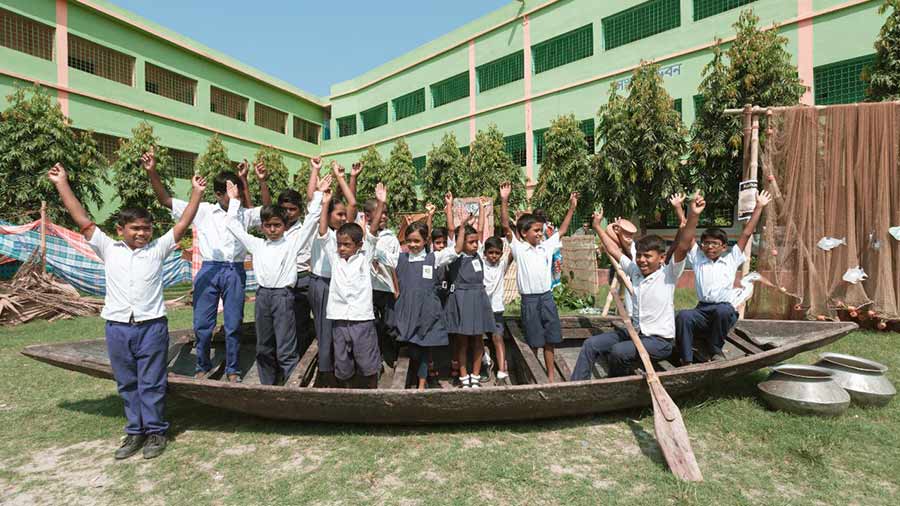
Photo by Goethe Institut/ Max Mueller Bhavan
On Wetlands
Disappearing Dialogues Collective at Kheyada High School held on October 21 depicted the role of wetlands and their significance vis-a-vis climate change. Apart from the visual documentation, activity kits and information exchange regarding the wetlands, the major highlight was ‘The Wetland Trails’ which was guided by the community children and the trail leaders.

Goethe Institut/ Max Mueller Bhavan
Sharmistha Sarker, programme officer, Goethe Institut/Max Mueller Bhavan, said, “Towards A Better Tomorrow was conceived because there was a need to create public awareness about the important issues concerning the environment and its sustainability. It was important for us to approach the Science City and Victoria Memorial Hall or even Kheyada High School, part of east Kolkata Wetlands. This partnership brings together important stakeholders. This collaboration was important as together we could bring about a certain level of change. We are not trying to change the world but do a little bit to make people aware of what is happening around us and maybe motivate them towards leading a more sustainable life through simple practices that one can follow at home.’’
